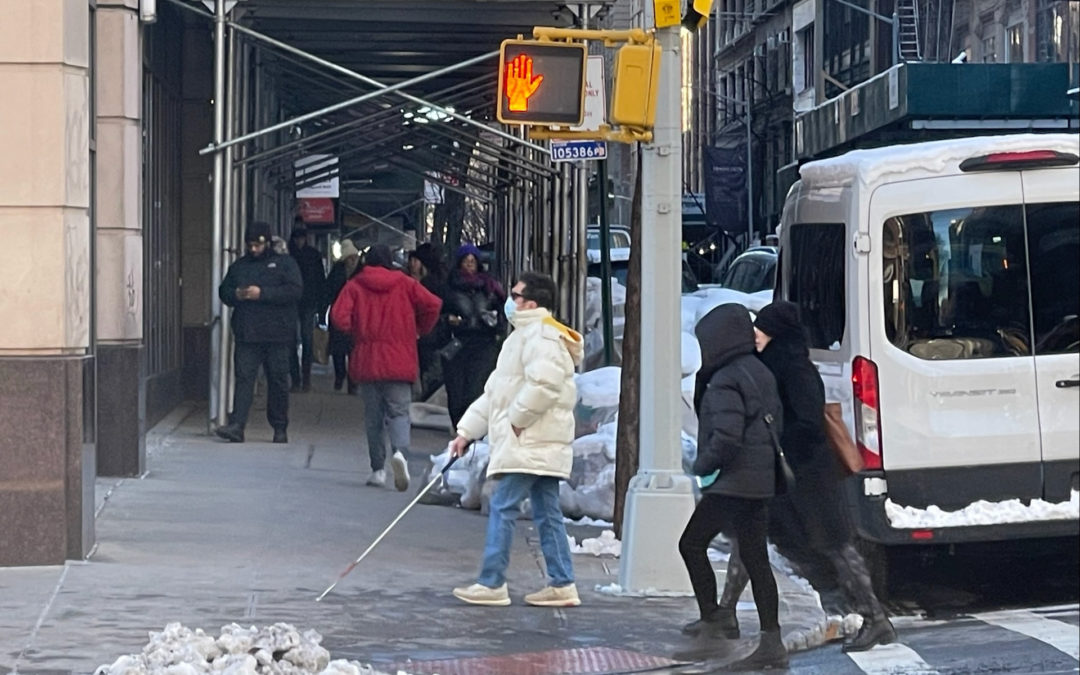The smartphone has revolutionized the mobility of blind and visually impaired people.
![[INFOGRAPHIC] Smartphone Use and Activities by People with Disabilities](https://www.inclusivecitymaker.com/wp-content/uploads/2020/02/smartphone_use_blind_people-min-1080x675.jpg)
[INFOGRAPHIC] Smartphone Use and Activities by People with Disabilities

[INFOGRAPHIC]
Smartphone Use and Activities by People with Disabilities
« Les personnes handicapées n’utilisent pas de smartphones. »
Aujourd’hui, les smartphones offrent des solutions d’assistance fiables et économiques aux personnes handicapées. Applications, GPS, paramètres d’accessibilité… la plupart de ces fonctionnalités sont devenues essentielles pour surmonter les obstacles du quotidien, mais aussi pour profiter de ces trésors technologiques au même titre que le reste de la population.
On croit souvent à tort que les personnes handicapées ne peuvent pas utiliser de smartphone. Pourtant, qu’elles souffrent de handicaps sensoriels, cognitifs ou moteurs, elles ont bel et bien accès aux technologies mobiles, avec toutefois quelques variantes pour certaines activités.
Regardez par vous-même !

L’étude a été menée entre 2015 et 2016 par le Centre de recherche en ingénierie de réadaptation pour les technologies sans fil Shepherd Center.
Au total, 7 500 personnes présentant une typologie de handicap ont répondu à l’enquête, qui se répartit comme suit :
Difficulté à marcher, à se tenir debout ou à monter les escaliers : 42 %
Malentendants : 31 %
Sourds : 12 %
Malvoyants : 13 %
Aveugle : 6 %
Difficulté à utiliser les mains ou les doigts 25 %
Difficulté à se concentrer, à prendre des décisions ou à se souvenir : 21 %
Inquiétude, nervosité ou anxiété fréquentes : 23 %
Difficulté à utiliser les bras : 20 %
Difficulté à parler : 17 %
5 chiffres clés :
⊗ 84 % des répondants déclarent utiliser un smartphone au quotidien
⊗ Atteignant 91 % en incluant l’utilisation des tablettes
⊗ Les personnes handicapées utilisent le GPS de leur smartphone 30 % de plus que le reste de la population
⊗ Ce qui représente 72%
⊗ 70 % d’entre eux utilisent des applications.
L’étude a été réalisée entre 2015 et 2016 aux États-Unis par le Rehabilitation Engineering Research Center for Wireless Technologies Shepherd Center : lire l’enquête complète .
Informations complémentaires :
Vous vous demandez comment les personnes malvoyantes utilisent un smartphone ? Cette question revient souvent, et c’est normal !
Le smartphone devrait être synonyme d’inaccessibilité pour les personnes aveugles et malvoyantes. Pourtant, il est devenu un compagnon indispensable pour beaucoup d’entre elles.
Découvrez comment : Le smartphone, une révolution pour les aveugles et malvoyants !
media

91% of people with disabilities use a smartphone or a tablet on a daily basis.
writer

Zoe Gervais
Content Manager
stay updated
Get the latest news about accessibility and the Smart City.
other articles for you

Why Should Your Accessible Pedestrian Signals Have a Guiding Sound Corridor?
A guiding sound corridor provides blind and visually impaired users more safety while crossing the street.

Blindness, Low Vision, What Are the Different Forms of Visual Disability?
There are many types of visual impairment affecting the lives of millions in the world. But accessibility solutions can make their lives easier.

8 Clichés on Accessibility for Blind and Visually Impaired People
Do you really know about accessibility for the visually impaired or do you think you know? Let’s take down some clichés!

Intellectual Disability, a Little Known and Multidimensional Disability
Even though intellectual disability affects 1 to 3% of the world’s population, there are still a lot of preconceived ideas.
share our article!
more articles

What Accessibility Solutions for Different Types of Physical Disabilities?
What Accessibility Solutions for Different Types of Physical Disabilities? Usually, when we think about physical disabilities, we visualize a wheelchair pictogram related to wheelchair users. But physical disabilities also concern people with reduced mobility...

How Can Multimodal Transit Centers Be Accessible for People with Disabilities?
How Can Multimodal Transit Centers Be Accessible for People with Disabilities?Multimodal transit centers turn out to be major nodes of transportation in large cities that aim at improving transport efficiency. They can easily connect together different means of...

Why Should Your Accessible Pedestrian Signals Have a Guiding Sound Corridor?
Why Should Your Accessible Pedestrian Signals Have a Guiding Sound Corridor? A guiding sound corridor brings more safety to blind and visually impaired pedestrians. They rely on accessible pedestrian signals at crossings to get around in the city with complete...

7 Tips to Welcome a Person with Disabilities
7 Tips to Welcome a Person with Disabilities Who hasn’t been uncomfortable dealing with a person with disabilities? We’ve all been afraid to drop a clanger, to be clumsy and to behave badly. It’s normal to feel disconcerted in a new situation when we don’t...
NEVER miss the latest news about the Smart City.
Sign up now for our newsletter.
Unsubscribe in one click. The information collected is confidential and kept safe.
powered by okeenea
The French leading company
on the accessibility market.
For more than 25 years, we have been developing architectural access solutions for buildings and streets. Everyday, we rethink today’s cities to transform them in smart cities accessible to everyone.
By creating solutions ever more tailored to the needs of people with disabilities, we push the limits, constantly improve the urban life and make the cities more enjoyable for the growing majority.


















Recent Comments